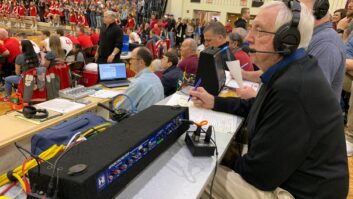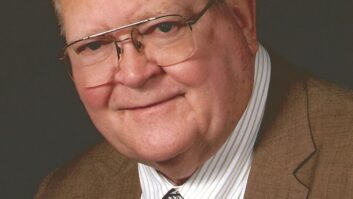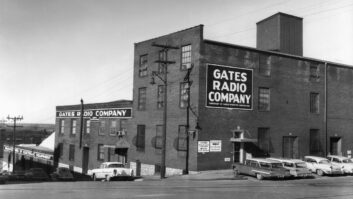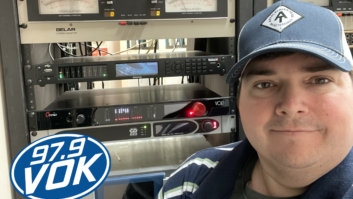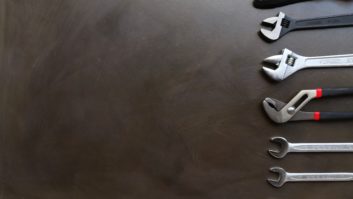(click thumbnail)Every air personality has a story about how he or she got that first gig. No matter how much the radio industry has changed over the decades, the urge to tell a story of your first radio job is a constant.
The thing that has changed is how people get that first break.
Some people, like myself, got their first radio job without having gone to broadcast school first. Others went a more “traditional” route and went to broadcast school/college and entered the industry upon graduation.
There is now another option that future radio personalities have in making that first step into the world of radio: “Broadcast School in a Box.”
How-to
This is the brainchild of Marc Elliot Hochman, who works in sales at a radio station in Florida. He declined to name the station, saying only that it is owned by one of the major broadcast groups.
The video is a 90-minute instructional about how to become an air personality or sportscaster. It provides tips from radio professionals including air talent, sportscasters, traffic reporters and program directors on how to get that first radio job. It provides a step-by-step tutorial on creating an air check tape and includes instruction on how to enhance your voice.
But can someone receive the information necessary to enter the radio industry in just 90 minutes and expect to earn an air position at a radio station?
“The purpose of the video is to act as a primer course for radio for those individuals who have an interest in getting into the industry,” Hochman said.
“The video gives people an affordable way to get an introduction into radio. After watching this video, people will have a better idea about whether or not they want to get into radio.”
Hochman believes traditional broadcasting schools and colleges are not preparing people fully for what they will experience in the day-to-day operations of the industry.
“There are a lot of radio stations out there, but not a lot of schools,” Hochman said. “If a person, whether they are just out of high school or looking for a new career, wants to go to broadcast school or college, he or she is looking at spending a lot of time and money and may have to move in order to attend school.
“Why go to all of that trouble and then find that radio isn’t for you? The video gives people the opportunity and information they need in order to make that choice. I’m trying to fill a void, to serve an underserved population.”
Hochman, a former instructor at the Connecticut School of Broadcasting in North Palm Beach, Fla., attended the University of Miami and landed a job at the college’s radio station, WVUM(FM), in his freshman year.
Later he became the station’s underwriting director and its program director. After he graduated in 1991, Hochman did a summer internship at WBBM(FM) in Chicago.
“I asked everyone within earshot at B96 about radio. I wanted to learn about radio, about how they got where they are.”
Hochman has used this “ask-everyone-within-earshot” philosophy as the foundation to his program.
“When I started choosing the material for the video, I wanted to get a cross-section of air personalities in a variety of markets to say, ‘Here’s how I did it.’ I wanted to show people all of the different jobs, the opportunities there are in radio and provide information about each and show people how to take that first step,” he said.
Response has not been universally positive by any means.
Primer
“There has been a ton of skepticism from the industry,” Hochman admits.
That’s understandable, I think. Radio is not learned merely by watching or reading but by performing. To make a claim that one could learn to be an on-air personality from a video would be like saying you could watch a training video on how to be a professional baseball player and then getting a position on a major-league baseball team.
Hochman doesn’t necessarily disagree, but states that the video was not meant to be a “be-all end-all” trainer for the industry but rather a primer for it.
“When I talk to industry people about ‘Broadcast School in a Box,’ I preface it by saying that if people can afford broadcast school, they’ll get a thousand times more experience.
“People obviously need the hands-on radio skills in addition to the information they get on the video. You can’t learn everything you’ll need to know about radio in 90 minutes. Again, the video is meant to be a primer to the radio business.”
Response from outside radio has been better.
“It’s been tremendous,” Hochman stated. “I receive about five to 10 e-mails a week about the video. We’ve sold tapes in the hundreds across the country and to places such as the United Arab Emirates, the Dominican Republic and Bahrain.”
Many users, especially in other countries, don’t have easy access to broadcast schools, he said. The video gives them a tool to make the choice about whether radio is for them.
Hochman has received some success letters from individuals who have purchased the video and have started a career in radio, and says he has received no complaints.
“I have been pleased with the sales of the video, especially since we haven’t done a lot of marketing. We have the Web site where people can order the video, but mainly we have distributors who sell it to schools and retailers.”
Reality
How does the tape prepare hopefuls for radio’s consolidated landscape?
“The video really doesn’t prepare people for consolidation,” said Hochman. “Whether it is good or bad, (consolidation) is a reality and people need to realize that. Consolidation doesn’t change the fact that you need talent and to work hard to succeed in radio. You need to continue working on your skills to be good.
“There are fewer options out there if you’re not as good as the rest. I think consolidation has raised the talent level of the industry … the cream rises to the top. If you’re really good, you could rise through the ranks.”
After viewing “Broadcast School in a Box”, I can see its value to radio hopefuls. It provides an inside look at radio from the point of view of on-air personalities and program directors, as well as Hochman himself. I now show it to my students in my radio classes to give them a look at the industry they are seeking to enter.
The video features tales of the industry from people working in the industry and each gives his or her advice on what it takes to be successful in this business. Tips from program directors regarding job-seeking are helpful.
There is a section of the tape on compilation of an audition tape and a scoped five-minute air check as an example. The audition tape can be difficult for students to grasp. This portion of the video makes the process of making a tape easy to understand.
The only section of the video at which I scoffed was the vocal instruction. Yes, proper vocal techniques are important, but I am skeptical that someone could be instructed on this topic in five minutes through a video.
Hochman described “Broadcast School in a Box” as a primer, and I agree. However, it’s no replacement for practical, hands-on experience – the best teacher for radio hopefuls.
Connecting
Hochman has teamed with Radio Connection in an effort to provide that hands-on experience.
Jimi Petulla, president of Radio Connection, describes his service as a direct connection between people looking to break into the radio business and radio stations looking to hire new talent.
“We select and hire successful radio program directors to be both counselor and mentor to our students, providing guidance throughout our training course. The director also monitors all scheduled training sessions at the station. Because students are actually assisting radio staff and learning in a hands-on situation, they are becoming that ‘known quantity with experience’ who are in the ideal position to go on-the-air at their station.”
Petulla agrees with Hochman about the failure of colleges and broadcasting schools to train future radio professionals adequately.
“Colleges and broadcasting trade schools provide an education, not experience. There is no way for these schools to re-create the dynamics of the real commercial radio station.
“Our trainees learn the real world of broadcasting by working with professionals who announce to thousands of listeners everyday. Therefore they not only receive training, but also develop a background of proven job experience as well as industry references. The combination of all three look great on a résumé.”
Now that “Broadcast School in a Box” is partnering with an organization through which actual on-air experience can be obtained, it remains to be seen if the primer will become the actual broadcast school he envisions.
“Broadcast School in a Box” is available on video and CD-ROM. You can get a free copy by calling the number listed below.
For information visitwww.broadcastschool.comor call (800) 295-4433. Information also is available throughwww.radioconnection.com.






